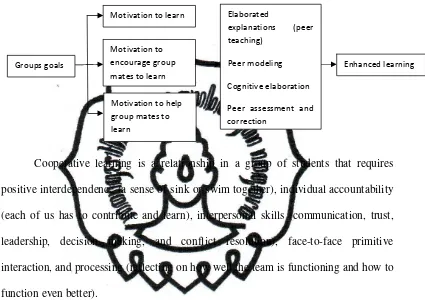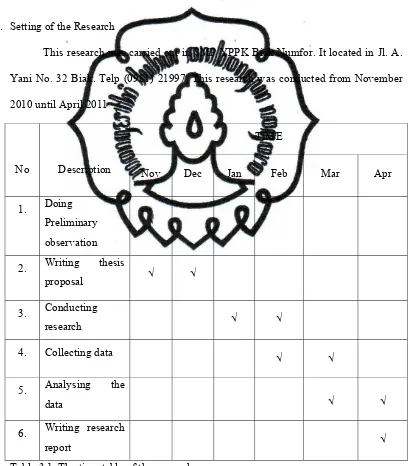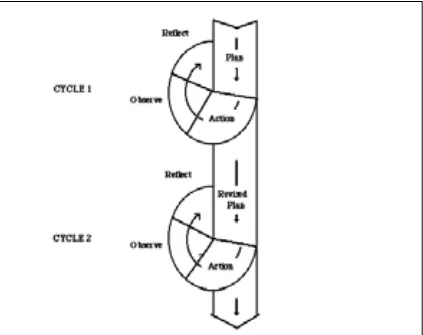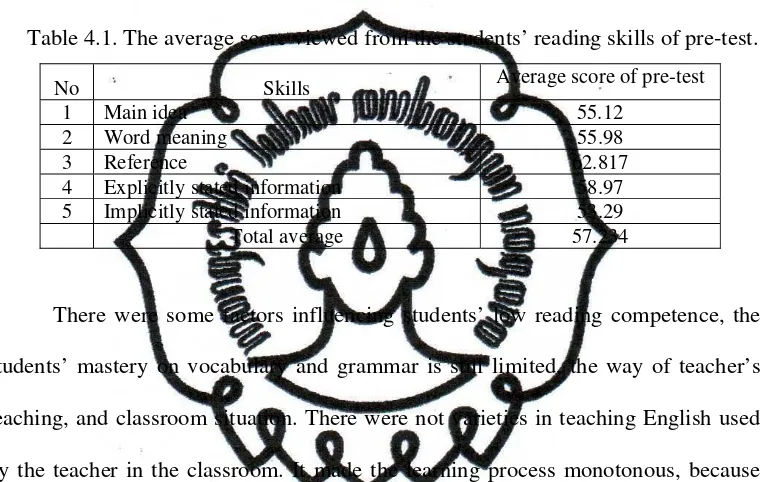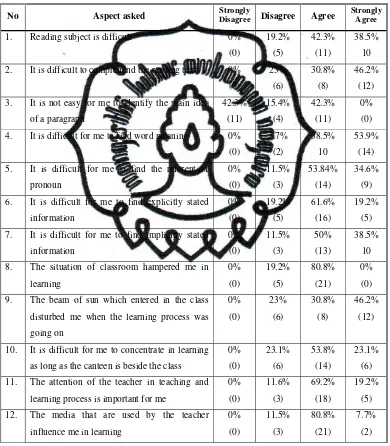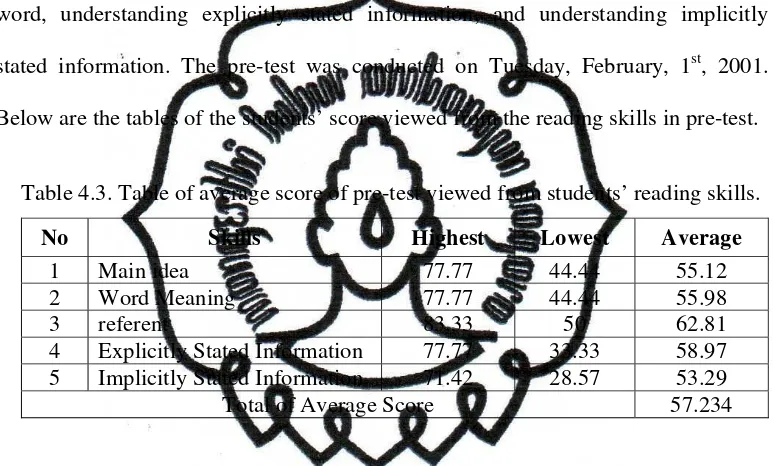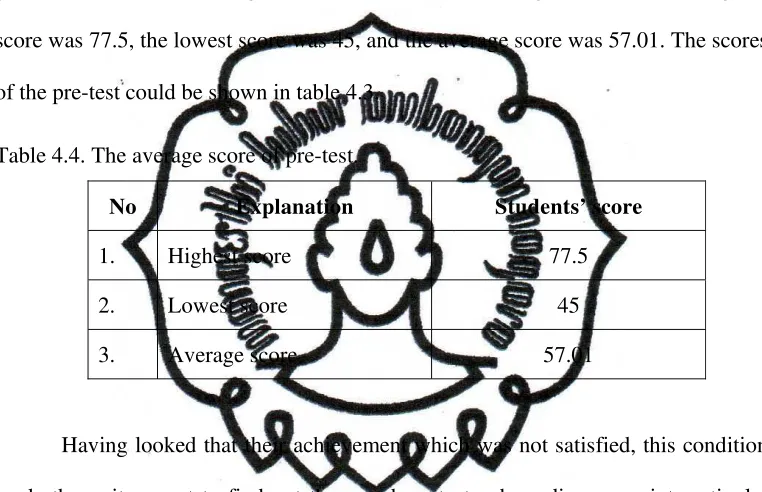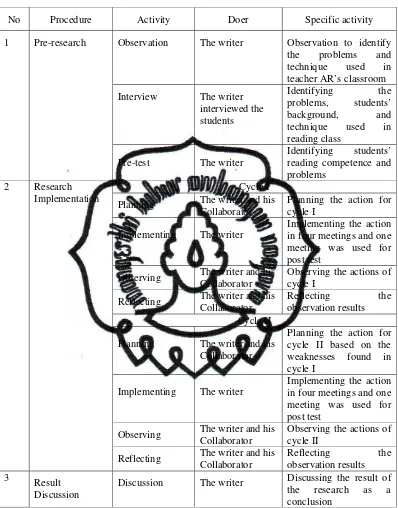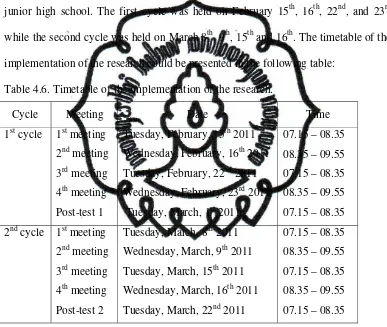IMPROVING STUDENTS’ READING COMPETENCE THROUGH
TWO STAY TWO STRAY TECHNIQUE
(A Classroom Action Research to the Students of Class VIII A of SMP YPPK
Biak Numfor in the Academic Year of 2010/2011)
THESIS
By
AUGUST LEWAHERILLA
NIM: S890809305
Written to Fulfill One of the Requirements of Graduate Degree of English
Education of Sebelas Maret University
ENGLISH EDUCATION DEPARTMENT
GRADUATE PROGRAM
MOTTO
The Lord is my Strength and my Song, He has become my Salvation, He is my
God, and I will praise Him, my father's God, and I will exalt Him (Exodus 15:2)
PRONOUNCEMENT
This is to certify that I myself write this thesis, entitled “Improving
Students’ Reading Competence Through Two Stay Two Stray Technique”, A
Classroom Action Research to the Students of class VIIIa of SMP YPPK Biak
Numfor in the Academic Year 2010/2011. It is not plagiarism or made by others.
Anything related to others’ work is written in Quotation, the source of which is
listed on the bibliography.
If then this pronouncement proves wrong, I am ready to accept any
academic punishment, including the withdrawal or cancellation of my academic
degree.
Surakarta, August
8
th, 2011
August
Lewaherilla
S890809305
ABSTRACT
AUGUST LEWAHERILLA.
Improving Students Reading Competence Through Two
Stay Two Stray Technique (A Classroom Action Research to the Students of Class
VIIIA of SMP YPPK Biak Numfor in the Academic Year of 2010/2011)
. Thesis.
Surakarta. English Education Department. Graduate School, Sebelas Maret University.
The aim of the this thesis is to know whether
two stay two stray
technique can
improve students’ reading competence for the students of class VIIIa of SMP YPPK
Biak or not, and to know the strengths and the weaknesses of the
two stay two stray
technique when it is applied in teaching reading. The preliminary research showed that
the students had problems on main idea, word meaning, referent word, explicitly stated
information, and implicitly stated information.
The research was done in SMP YPPK Biak Numfor from January- March 2011.
The subject of the study was the students of class VIIIa of SMP YPPK Biak Numfor
consisting of 26 students. It was a classroom action research. The writer did some steps
for each cycle. They were planning, action, observation, and reflection. In collecting
the data, the writer applied several techniques including observation, interview,
questionnaire, and test. The quantitative data were analysed by using descriptive
statistics. It compared between the scores of pre-test (before implementing two stay
two stray technique) and post-test (after implementing two stay two stray technique),
while the qualitative data were analysed by using constant comparative method which
consisted of comparing incidents applicable to each category, integrating categories
into their properties, delimiting theory, and writing theory.
The result of the research showed that: (1) two stay two stray technique can
improve students’ reading competence, which covered: main idea, word meaning,
referent word, explicitly stated information, and implicitly stated information. The
improvement can also be seen from their results of post-test. The averages of the scores
improved from cycle to cycle. The average score of pre-test was 57.019. Then, it
increased to 64.62 in post-test 1 and 72.788 in post-test 2, and (2) The students became
more active and enthusiastic in learning process. They were brave to give their opinion
using English language. Besides, the class became active and alive. Moreover, they
could collaborate with others well.
In conclusion, two stay two stray technique is able to improve students’ reading
competence. It stimulates students to be responsible and active. In short, it is
recommended that the English teachers use two stay two stray technique in teaching
reading competence, so that it can be students’ own reading strategy in order to
improve their reading competence.
TABLE OF CONTENTS
TITLE PAGE ...……….……….
APPROVAL...
LEGALISATION...
PRONOUNCEMENT ...
ABSTRACT……….
MOTTO ...
DEDICATION ...
ACKNOWLEDGEMENT ...
TABLE OF CONTENT ……….……….
LIST OF TABLE……….
LIST OF FIGURE………
LIST OF APPENDICES………..
ii
iii
iv
v
vi
vii
viii
ix
x
xii
xiii
xiv
CHAPTER I
INTRODUCTION ………..
A.
Background of the Study……….
B.
Problem Formulation ……….……….
C.
The Research Objective ………..……….………..
D.
The Research Benefits………
1
1
7
7
7
CHAPTER II
REVIEW OF RELATED LITERATURE ……….
A.
Reading ……….………..
1.
Definition of Reading ……….………
2.
Purpose of Reading ……….……….
3.
Micro- and Macro-skills for Reading Comprehension ………
4.
Strategy of Reading ……….
B.
Cooperative Learning………...
1.
Two Stay Two Stray………..
C.
Rationale ………..………..
D.
Action Hypothesis ………..……
9
9
9
12
12
15
16
24
28
30
A.
Setting of the Research ………...
B.
Subject of the Research ……….……….
C.
The Method of the Research ……….
D.
Procedure of the Research ………..
E.
Technique of Collecting the Data ………...
F.
Technique of Analysing Data ……….
31
32
33
38
56
42
CHAPTER IV
RESEARCH FINDING AND DISCUSSION………..
A.
Introduction………
B.
The Description of Previous Situation………
C.
The Implementation of the Research………..
D.
Research Findings………
E.
Discussion………
51
51
51
61
112
117
CHAPTER V
CONCLUSION, IMPLICATION, AND SUGGESTION………..
A. Conclusion………
B. Implication………
C. Suggestion………
123
123
124
125
BIBLIOGRAPHY ………..
127
LIST OF TABLE
Tabl
e 3.1
Tabl
e 4.1
Tabl
e 4.2
Tabl
e 4.3
Tabl
e 4.4
Tabl
e 4.5
Tabl
e 4.6
Tabl
e 4.7
Tabl
e 4.8
Tabl
e
4.11
Tabl
e
4.12
The Time Table of the
Research………...
The Average Score of Pre-test Viewed from Students
reading
Skills………
…..
Result of Questionnaire before
Cycle……...………...…...
The Average Score of Pre-test viewed from student’ reading
skill………
…..
The Average score of
Pre-test………..………
Procedure of the
Research………..……….
Time Table of the Implementaion of the
Research……..……….
The Average Score of Pre-test and Post-test
1……..…………..
The Average Score of Pre-test and Post-test 1 viewed from
students reading
skills………...
The average score of post-test 1 viewed from students’
reading
skills………
….
The average score of pre-test, post-test 1, and post test 2
Tabl
e
4.13
Tabl
e
4.14
Tabl
e
4.15
Tabl
e
4.16
Tabl
e
4.17
Post-test score of cycle 2 viewed from students’ reading
skills...
The average score viewed from the students’ reading skills
of pre-test, post-test 1, and post-test
2……….
The average score of pre-test, post-test 1, and post-test 2
viewed from students’ reading
skills……….
The level of the students’ reading competence of pre-test,
post-test 1, and post-test
2………
The result of questionnaire after
cycles………
6
LIST OF FIGURE
Figure 2.1
Figure 3.2
Figure 4.3
Factors Influencing Learning Gains..………..
Cyclical Action Research……….
The students’ Mean Score Improvement of Reading
Competence……….
19
38
114
LIST OF APPENDICES
Appendix 1.a
Appendix 1.b
Appendix 2.a
Appendix 2.b
Appendix 2.c
Appendix 3.a
Appendix 3.b
Appendix 4.a
Appendix 4.b
Appendix 5.a
Appendix 5.b
Appendix 5.c
Appendix 6.a
Appendix 6.b
Appendix 6.c
Appendix 6.d
Appendix 6.e
Appendix 7.a
Appendix 7.b
Appendix 7.c
Appendix 7.d
Appendix 7.e
Appendix 8
Appendix 9.a
Appendix 9.b
Appendix 10
Appendix 11
Appendix 12
Questionnaire 1 ..….……….………
Questionnaire 2 ..….……….
Students’ Interview before cycle.……….
Students’ Interview after cycle ……….
Collaborator ‘s Interview …..………..……….
Blue Print of Try Out ………..……….
Instrument of Try Out ..………
Validity of the Instruments ……….……….
Reliability of the Instruments ………..
Blue Print of Pre-test .………..
Instrument of Pre-test ..………
Result of Pre-test ……….
Lesson Plan of Cycle 1 ..………..
Field Note Result of Cycle 1 ……….…………..
Blue Print of Post-test 1 ………..……….
Instrument of Post-test 1 ………..………
The Result of Post-test 1 ………..………
Lesson Plan of Cycle 2 ………..………..
Field Note Result of Cycle 2 ………….………..
Blue Print of Post-test 2 …………..……….
Instrument of Post-test 2 …………..………
The Result of Post-test 2 ………..………
Sample of Students’ Worksheet...
T-test Non Independent between Pre-test and Post-test 1 ...
T-test Non Independent between Post-test 1 and Post-test 2 ...
Letter of Permission …………..……….
Letter of Having Conducted the Research ………..……….
CHAPTER I
INTRODUCTION
A. Background of the Study
these. So, mastering language as a means of communication in human life is very important.
The ability to read makes one get closer to wider information from texts, especially English written texts.
It is stated by Moreillon (2007: 10) that reading is making meaning from print and from visual information. She adds reading comprehension strategies are tools that proficient readers use to solve the comprehension problems they encounter in texts, while Zimmermann and Hutchins in Moreillon (2007: 11) identify seven reading comprehension strategies: (1) activating or building background knowledge; (2) using sensory images; (3) questioning; (4) making predictions and inferences; (5) determining main ideas; (6) using fix-up options; and (7) synthesizing, while Chesla (2009: 17) states that reading comprehension covers four basics: (1) finding the basic facts in a passage; (2) determining the main idea of a passage; (3) determining the meaning of unfamiliar words from context; and (4) distinguishing between fact and opinion.
one of the materials that are tested. The questions presented in this test are usually around understanding the meaning of the texts and dialogues by deciding the topic of the text, finding information in detail, finding explicit and implicit information of the text, finding main idea, finding references, synonym, and antonym (Panduan materi Bahasa Inggris SMP/MTsN-Depdiknas in Asih 2006: 178).
Permendiknas No. 22 year 2006 states that the competence standards of reading at the first semester of the second grade at Junior High School are as follows:
Competence standards: Berkomunikasi secara lisan dan tertulis dengan menggunakan ragam bahasa yang sesuai dengan lancar dan akurat dalam
wacana interaksional dan monolog terutama dalam wacana berbentuk
descriptive.
Basic competence: (1) Memahami nuansa makna dan langkah-langkah pengembangan retorika di dalam teks tertulis dalam bentuk descriptive
sederhana, serta instruksi/ larangan pendek; (2) Mengungkapkan nuansa makna dengan langkah-langkah pengembangan retorika yang benar di
dalam teks tertulis berbentuk descriptive sederhana; (3) Memahami berbagai
makna dan langkah-langkah pengembangan retorika di dalam teks tertulis
berbentuk deskriptif sederhana.
identify reference of the word, and to understand explicitly and implicitly stated information.
However, in SMP YPPK Biak Numfor Regency, Province of Papua, many students have problems in their four skills of English, especially in reading skill. The problem faced by students here is the low reading competence of the students. The students’ mastery on vocabulary and grammar is still limited. For examples, the students at class VIIIa generally do not understand what their teacher wrote on the blackboard, asked them to do something in English. They have difficulties in comprehending reading text, especially related to the understanding of: (1) main idea of the text; (2) word meaning; (3) identify reference of the word, (4)explicitly stated information, and (5) implicitly stated information.
The other problem happened because there are not varieties in teaching English used by the teacher in the classroom, the teacher only uses a method in the whole day, even for a semester. It makes the learning process monotonous, because the class is dominated by the teacher, and the students do not have opportunity to develop their communicative competence. Therefore, the class seems boring to the students. The students are lazy to come to an English class.
To respond this condition, the writer will use one of cooperative learning methods; that is two stay two stray technique, as a technique to improve their reading competence. The writer is sure that two stay two stray technique can be more interesting than other ways, because it can make learning more enjoyable, students can create their ideas and share with their friends in groups to achieve their learning goal in which they work together to share their understanding about the text, of course, the topics which are related to academic materials. In two stay two stray technique, the students will be divided into several groups, a group contains four students. Two students stay to receive visitor from other groups and two students stray to the other groups. The teacher will explain about the generating ideas of the topic, after that the teacher gives a text to the students to be discussed in their group and shared with other groups to recognize word meaning of the text, to identify its main idea, to understand its lexical devices, to identify reference of the word, and to understand explicitly and implicitly stated information of the text. Therefore, the students are hoped be able to find out some of new words, creating ideas and sharing them each other according to the text the teacher gives them, beside that, the students will be able to identify main idea, recognise word meaning, identify reference of the word, understand explicitly stated information,and understand implicitly stated information.
Therefore, the writer is interested in conducting a research entitled “IMPROVING STUDENTS’ READING COMPETENCE THROUGH TWO STAY
B. Problem Formulation
Based on the description above, the problems can be formulated as follows: 1. Can two stay two stray technique be an effective way in improving students’
reading competence?
2. What are the strengths and weaknesses when two stay two stray technique is applied in teaching reading?
C. The Research Objective
The objectives of this research are:
1. To know whether two stay two stray technique can improve students’ reading competence.
2. To know the strengths and the weaknesses of the two stay two stray technique when it is applied in teaching reading.
D. The Research Benefits.
other researchers. The writer hopes that this study can gives more understanding about two stay two stray implemented in classroom and can be a reference for other researcher in the future time.
CHAPTER II
REVIEW OF RELATED LITERATURE
It is important to elaborate some theories, which are used in this research in order to have an understanding of certain concepts. The concepts are related with theoretical description underlying research, rationale, and action hypothesis.
A. Reading
1. Definition of Reading
Reading is what happens when people look at a text and assign meaning to the written symbols in that text (Aebersold and Field 1997: 15). Williams (1984: 2) adds that a simple (and provisional) definition of reading is a process whereby one looks at and understands what has been read. He adds the key word here is ‘understand’ – merely reading aloud without understanding does not count as reading, while Heilman (1981: 182) states that reading is a complex process in requiring not only the ability to recognise words, but also the ability to comprehend and evaluate the meaning of written text. Meanwhile, according to Davies (1995: 1) reading is private. It is a mental or cognitive process which involves a reader in trying to follow and respond to a message from a writer who is distant in space and time.
if not directly stated; (5) recognizing the structural methodology employed to develop the passage, for example, sequencing; and (6) extending limited information given by the author to a logical conclusion using inference.
Heaton (1988: 105-106) defined reading as the ability to: (1) recognise words and word groups; (2) deduce the meaning of words; (3) understand explicitly stated information; (4) understand relations within the sentence; (5) understand relations between parts of a text through both lexical devices, grammatical cohesive devices, especially anaphoric and cataphoric reference, and connectives; (6) perceive temporal and spatial relationships, and also sequences of ideas; (7) understand conceptual meaning; (8) anticipate and predict what will come next in the text; (9) identify the main idea and other salient features in a text; (10) generalise and draw conclusions; (11) understand information not explicitly stated by (a) making inferences, and (b) understanding figurative language; (12) skim and scan; (13) read critically; and (14) adopt a flexible approach and vary reading strategies according to the type of material being read and the purpose for which it is being read.
associate the form with a sound or meaning acquired in the past, and on the basis of past experience, understand, and interpret its meaning. So, reading involves processing language message.
Gere, et al. (1992: 51) state that reading students as individual learners is important, but it is also true that these individual students come together in groups. They add if our goals are to help students become enthusiastic, thoughtful, independent readers, we must give them opportunities to select their own reading material (1992: 250). According Vaughn, et al. (2000; 371) there are six factors which influence reading: (1) cognitive factors: intelligence, memory, attention span, cognitive learning strategies; (2) neurophysiological factors: auditory acuity, visual acuity, brain development, brain function; (3) educational factors: opportunity for appropriate instruction, exposure to print, quality of early reading instruction, early intervention of reading problems; (4) communication factors: listening abilities, speaking abilities, language abilities, (5) personality factors: motivation, sense of personal competence, ability to work in groups, consistency in behavior willingness to ask for help; and (6) textual factors: print type, clarity of writing style, vocabulary, sentence structure, format design.
Ur (1996: 138) states there are some assumptions about the nature of reading: a. Perceiving and decoding letters in order to read words.
b. Understanding all the words in order to understand the meaning of a text.
c. The more symbols (letters or words) there are in text, the longer it will take to read it.
e. The understanding of a text comes from understanding the words of which it is composed.
2. Purpose of Reading
A person may read for enjoyment or to improve his/her knowledge. According to Davies (1995: 133-134) reading purposes are (1) for pleasure: to follow a narrative and enjoy the ‘sound’ and rhythm or rhyme of a literary text; (2) for a general impression: to gain an idea of the writer’s viewpoint, gain an overall impression of the ‘tone’ of a text, and to decide whether or not to read the text; (3) for organizing reading and study: to identify the important content a text, to answer a specific question(s), and to decide which section of a text to start studying; (4) for learning content or procedures: to gain an understanding of new concepts, learn certain facts from text, and to follow instructions; and (5) for language learning: it is for ‘translating’ the text, literally, or metaphorically, and then to learn new vocabulary, to identify ‘useful’ structures or collocations, to use the text as a model for writing, and to practice pronunciation.
Good readers read extensively, integrate information in the text with existing knowledge, have a flexible reading style, depending on what they are reading.
3. Micro- and Macro-skills for Reading Comprehension
a. Micro-skills
1) Discriminate among distinctive graphemes and orthographic patterns of English.
2) Retain chunks of language of different lengths in short-term memory. 3) Process writing at an efficient rate of speed to suit the purpose.
4) Recognise a core of words, and interpret word order patterns and their significance.
5) Recognise grammatical word classes (nouns, verb etc.) systems (e.g. tense, agreement, pluralisation), patterns, rules, and elliptical forms.
6) Recognise that a particular meaning may be expressed in different grammatical forms.
7) Recognise cohesive devices in written discourse and their role in signaling the relationship between and among clauses
8) Recognise grammatical word classes (nouns, verb etc.) systems (e.g. tense, agreement, pluralisation), patterns, rules, and elliptical forms.
b. Macro-skills
1) Recognise the rhetorical forms of written discourse and their significance for interpretation.
2) Recognise the communicative functions of written texts, according to form and purpose.
4) From described events, ideas, etc. Infer links and connections between events, deduce causes and effects, and detect such relations as main idea, supporting idea, new information, given information, generalisation, and exemplification. 5) Distinguish between literal and implied meanings.
6) Detect culturally specific references and interpret them in a context of the appropriate cultural schemata.
7) Develop and use a battery of reading strategies such as scanning and skimming, detecting discourse markers, guessing the meaning of words from context, and activating schemata for the interpretation of texts.
Reading is an activity which needs a prior knowledge to understand messages from a writer. Reading is not only an activity people do in a leisure time but also an activity to develop knowledge, competence, and etc. Reading needs a process, a process in people daily life to practice to read something every day. It must be as a habit for daily activity. Readers can interpret what they read, and it needs process to interpret the right message from written language. So, it comes to a conclusion that reading means ability in understanding the message from the written materials they read, in other words, people are not only hoped to know the word but also its meaning.
4. Strategy of Reading
To make reading comprehension successful, there are some strategies which can be practiced in the classroom technique. Davies (1995: 51) states there are five types of strategy, as follows:
a. Control reading process.
It engages consciously or unconsciously. The action of this process can be observable. For example, regressing, pausing, and marking text;
b. Monitor reading process.
It attempts to find ways into the meaning of the text and / or by evaluating such attempts.
c. Interact with text.
It expresses the feeling etc on the basis of at least an interim interpretation of the text; hence interaction represents a response to the text rather than the evaluation of a route into the text;
d. Utilise source of information.
It pays attention to linguistic features of the text, and/or on one’s own textual/linguistic knowledge as it is evoked by reading the text, for example, grammar, repletion of words, text structure, etc.
e. Utilise source of information
Furthermore, Brown (2003: 188-189) adds that the assessment of reading can imply the assessment of a storehouse of reading strategies. Here are some principles of strategies for reading comprehension;
a. Identify the purpose in reading a text.
b. Apply spelling rules and conventions for bottom-up decoding.
c. Use lexical analysis (prefixes, roots, suffixes, etc.) to determine meaning. d. Guess at meaning (of words, idioms, etc.) when you are not certain. e. Skim the text for the gist and for main ideas.
f. Scan the text for specific information (names, dates, key words). g. Use silent reading techniques for rapid processing.
h. Use marginal notes, outlines, charts, or semantic maps for understanding and retaining information.
i. Distinguish between literal and implied meanings. j. Capitalize on discourse markers to process relationship.
B. Cooperative Learning
instructional methods in which small groups of students work together and aid each other in completing academic tasks.
Haycraft (1978: 17) states that to give more practices in spoken English to your class, break them up into pairs or small groups. This encourages those who are shyer or reluctant to participate. Group work gives the students chances for greater independence. Because they are working together without the teacher controlling every move, they take some of their own learning decisions, they decide what language to use to complete a certain task, and they can work without the pressure of the whole class listening to what they are doing (Harmer, 1998: 21).
Johnson, et al. (1994: 21) state that within cooperative learning, there is a process of interpersonal exchange that promotes the use of higher-level thinking strategies, higher-level reasoning, and metacognitive strategies. Students working together cooperatively expect to, and do in fact, explain what they learn to group mates, elaborate on what is being learned, listen to others' perspectives and ideas, monitor each other's participation and contributions, give each other feedback, and engage in intellectual conflict. They add that cooperative learning is:
a. A small group interactive instructional strategy that allows students to collaboratively work on meaningful tasks.
b. Students work to help themselves and others in the group to learn. c. Academic engagement through social interaction.
d. Activities are structured so that students need each other to accomplish tasks. Cooperative Learning Strategy helps:
b. Students construct their own knowledge
c. Students develop social and group work skills necessary in life d. Promote positive interaction among students
e. Students learn through active involvement rather than sitting and listening and watching
According to Jolliffe (2007: 14) there are six items making how cooperative learning is inclusive:
a. Questions are never asked of individuals. If a question is worth asking, it is worth asking of everyone.
b. Children work in heterogeneous groups, which consist of mixed gender, ability, and background.
c. Children are supported and given training in interpersonal and small group skills. Regardless of background or home situation, there is no assumption that children can work with others effectively.
d. Every child contributes and their contribution is valued, indeed is crucial, to the success of the group.
e. Learning is active and social, not passive and as such it appeals to everyone, particularly boys.
f. It creates a mutually supportive classroom.
members lead to increase learning achievement, regardless of subject or proficiency level of students involved (see Figure 2.1).
Figure 2.1: Factors influencing learning gains (based on Slavin 1995: 45)
Cooperative learning is a relationship in a group of students that requires positive interdependence (a sense of sink or swim together), individual accountability (each of us has to contribute and learn), interpersonal skills (communication, trust, leadership, decision making, and conflict resolution), face-to-face primitive interaction, and processing (reflecting on how well the team is functioning and how to function even better).
There are six factors why cooperative learning enhances student learning: (1) providing a shared cognitive set of information between students; (2) motivating students to learn the material; (3) ensuring that students construct their own knowledge; (4) providing formative feedback; (4) developing social and group skills necessary for success outside the classroom; and (5) promoting positive interaction between members of different cultural and socio-economic groups. (http://www.utc.edu/Administration/WalkerTeachingResourceCenter).
Motivation to learn Elaborated
explanations (peer
teaching)
Peer modeling
Cognitive elaboration
Peer assessment and
correction Motivation to
encourage group mates to learn
Enhanced learning
Motivation to help group mates to learn
Cooperative learning is a generic term for various small group interactive instructional procedures. Students work together on academic tasks in small groups to help themselves and their teammates learn together. In general, cooperative learning methods share the following five characteristics: (1) students work together on common tasks or learning activities that are best handled through group work; (2) students work together in small groups containing two to five members; (3) students use cooperative, pro-social behavior to accomplish their common tasks or learning activities; (4) students are positively interdependent. Activities are structured so that students need each other to accomplish their common tasks or learning activities; and (5) students are individually accountable or responsible for their work or learning (http://www.utc.edu/Administration/WalkerTeachingResourceCenter/FacultyDevelop ment/CooperativeLearning/index.html).
Yamarik (2005: 3) defines cooperative learning as a teaching method where students work in small groups to help one another learn academic material. In the groups, students are expected to help each other to find answers to questions, rather than seeking answers from the instructor. Cooperative work rarely replaces teacher instruction, but rather replaces individual lecture and drill. If implemented properly, students in cooperative groups work with each other to make sure that everyone in the group understands the concepts being taught.
possibility is to encourage learners to motivate themselves through a self-access scheme where they choose and work on their own texts. The point is that cooperative learning involves more than just asking students to work together in groups. Instead, conscious thought goes in to help students make the experience as successful as possible.
Orlich, et al. (1998: 260) state that the group size is an important variable that influences learner participation. There is no absolute minimum or maximum number of persons that must be included in a small group to ensure a successful discussion. Ideally, group size in the classroom is two-six students work together to reach a common goal (http://www.cooperative learning article.pdf). Some suggest that four is the ideal size (Cohen, 1994: 3), while others assert that six is the maximum (Johnson 1994: 14). However, Orlich, et al. (1998: 260) suggest that the optimal group size is from six to eight students. When four or fewer individuals are involved in a discussion group, the participants tend to pair off rather than to interact with all numbers.
They have found when a group consists of ten or more participants, student interaction begins to diminish. With larger groups-that is, fifteen or more-a few students participate actively, a few participate in a more limited way, and most remain silent or passive. Therefore, they suggest to divide the class into groups of not more than four before initiating a small group.
a. Types of cooperative learning
According to Jolliffe (2007: 43) cooperative learning utilises three types of cooperative learning groups:
1) Formal cooperative learning groups: these last from one lesson to a few weeks and need to consist of the following to work effectively:
a) team-building activities to establish team identify and cohesion b) specific teamwork skills highlighted each lesson and/or week c) teacher monitoring and support for task and teamwork skills d) evaluation of learning and teamwork by pupils and teacher
2) Informal cooperative learning groups: these last from a few minutes to a whole lesson and usually consist of ‘turn to your partner’ discussion or think/pair/share and can be extended from pairs to fours or eights (often termed ‘snowballing’). 3) Cooperative base groups: these usually last for a term or a school year and consist
of heterogeneous cooperative learning groups with stable membership to build on support and encouragement to each other. The elements described in formal cooperative learning groups above will need to be incorporated and built on.
b. Role of the teacher
a. Plans lessons that decide on (1) objectives; (2) size of groups; (3) how to group pupils; (4) group roles; (5) organisation of the classroom; and (6) materials needed. b. Explains the task and the cooperative skill with criteria for the success of both. c. Monitors and intervenes with groups where necessary.
d. Evaluates the quality and quantity of achievement and ensures that groups reflect on their achievement and effectiveness as a group and set goals for improvement.
The formation of groups is a key part of the teacher’s role. It is stated by Jollifee (2007: 50) that there are three major ways to form groups in the classroom: a. Random selection. This is useful at the beginning of a lesson to help students to get
to know each other. This can be done by numbering everyone in the class (1–4) and then asking all the 1s to form a group, 2s a group, and so on. With an uneven number, explain that any students left can be ‘stars’ for the day and can choose which group to work with. Ensure that each group comprises a maximum of five students.
b. Student selection. It can cause difficulties, reinforce social cliques in the class and result in ‘off-task’ behavior if the students choose according to friendship. If, on occasions, students’ selection is seen as desirable, it may be better for them to select by other criteria than friends, for example they write a favorite pop group, television programme or sport on a slip of paper and then form a group with others that like the same.
When students first begin to work together in pairs or groups they may be unsure about what they have to do. Giving them a specific function or role within the group or pair will help them to take on responsibility for their own actions. The assignment of roles can help:
a. To foster positive interdependence – everyone must play their part if the group is to succeed
b. To help develop teamwork – teachers can introduce skills and functions needed in a group through the use of assigned roles for specific tasks
c. Assigning roles moves responsibility into the group and away from the teacher d. Many roles that can be assigned to students depending on the task to be undertaken
According to Orlich, et al. (1998: 276) the benefits of cooperative learning are: (1) improves comprehension of basic academic content; (2) reinforces social skills; (3) allow student decision making; (4) creates active learning environment; (5) boosts students’ self-esteem; (6) celebrates diverse learning styles; (7) promotes student responsibility; and (8) focuses on success for everyone.
1. Two Stay Two Stray
http://www.allbusiness.com). In this technique, two members of each cooperative group visit another group to share procedures near the beginning or middle of an activity, or findings near the end of an activity or session. The group member who strayed rejoins his/her original group to share what he/she learned from the visited group (http://www.biochemnetwork.com./download.php?). Two members from each group moves to another group and explains his/her original group’s explanation of the problem. If there are 10 groups you have 10 students simultaneously giving reports. A second rotation is also possible (http://www.hbe.com).
For example, students can work in groups to solve a set of problems for review. When they have completed the problem set, the teacher can signal groups to send two members to the group on the right. The stray and the visited group can compare answers to the problem set. They can discuss differences and attempt to arrive at common answers. When the stray has completed consulting, the stray returns to his/her group. The group now shares what they learned from the stray that visit and the group their stray visit. During the “straying,” the teacher may want to stay with one group to ensure that answers/problem solutions are correct. The teacher can reconvene the class to go over any information or problems that were unresolved.
the “diamond”) leaves it and rotates to an adjoining team to give the report. In large classes it is essential that the order of rotation is clear (http://www.utexas.edu/academic/ctl/gsi/coursedesign/basic.php).
Two stay two stray is one of cooperative learning approaches that students are involved in planning both the topics for study as well as how to proceed with their investigation (Arends, 1989: 409). Two stay two stray involves the integration of four essential features: investigation, interaction, interpretation, and intrinsic motivation (Sharan & Sharan, 1992 in www.users.muohio.edu 2010). It provides a social context for learning. Teachers who use the two stay two stray approach normally divide their classes into three or four member heterogeneous groups. In some instance, however, groups may be formed around four friendships or around an interest in particular topic. http://www.indiana.edu/bobweb/presentaion/present describes the following five steps of the two stay two stray procedures:
a. Give a task to small group of students.
b. Assign two persons as spy or pirate to see the answers of other students (one stray-three stay method) and share with group.
c. Group assigns two persons from their group to stay behind and share product or ideas with others who visit their poster or station.
e. Evaluation. In cases where groups pursued different aspects of the same topic. Pupils and teacher evaluate each group’s contribution to the work of the class as a whole. Evaluation can include either individual or group assessment, or both.
The other expert describes procedures of two stay two stray technique in each of the four rounds, two of the team members travel to another team to share his/her team’s ideas or product with that team.
a. In Round 1, #1 and # 2 travel with the team’s ideas or product one team to the right (or left). #3 and #4 stay and listen to the presentation by the visiting #1 and #2. All members return to the home teams.
b. In Round 2, #2 and #3 travel with the team’s ideas or product two teams to the right (or left). #3 and #4 stay and listen to the presentation by the visiting #2 and #3. All members return to the home teams.
c. In Round 3, #3 and #4 travel with the team’s (or left). #1, and #2 stay and listen to the presentation by the visiting #3 and #4. All members return to the home teams. d. In Round 4, #4 and #1 travel with the team’s ideas or product four teams to the
right (or left). #2 and #3 stay and listen to the presentation by the visiting #4 and #1. All members return to the home team.
Two persons from each team stay seated in the team’s place while the other teams rotate from table to table. The team’s representative shares the team’s information with all the other teams as they rotate through. (http://www.hbe.com.au/PUBLIC/HBEItemsImages/pdf/kA1554.pdf).
skills such as asking probing questions; (2) it offers students the opportunity to learn by teaching; (3) Placing the report-out responsibility on the students reinforces the valuable conception that knowledge resides within the learning community, not just with the “authority-figure” instructor. Meanwhile, the disadvantages of two stay two stray are: (1) active students dominate in discussing and some of the passive students depend on his /her friends in the group; (2) the students will not succeed if they cannot work well together as a team.
C. Rationale
Reading is one of the language skills that can be learned by students. Reading is about understanding written texts that contain messages from the writer. It is a complex activity that involves both perception and thought. Reading consists of two
related processes: word recognition and comprehension. Reading is not only a
receptive of taking information from page in word by word but also an active process to comprehend the text. Reading is not only an activity people do in a leisure time but also an activity to develop knowledge, competence, and etc. If students have good reading competence, they will be able to identify main idea, recognise word meaning, identify reference of the word, understand explicitly stated information, and understand implicitly stated information.
students’ reading competence is poor and make the students of class VIIIa are passive in English subject, especially reading skill. Those problems occur because: the students’ have low reading competence, lack of practices, and mastery on vocabulary and grammar is still limited.
The other problem comes from the teacher. The teacher only uses a method in her learning process, there are not varieties in her taught. Finally, the situation of the classroom. Because of class VIIIa is near the canteen, it makes the students’ concentration in learning a subject in the class, including English class hampered. Sometimes the students do not sit in to follow a lesson but hiding in the canteen until the break time or time to go home.
D. Action Hypothesis
CHAPTER III
RESEARCH METHODOLOGY
In this chapter, the writer would like to discuss research methodology which
contains: setting of the research, subject of the research, method of the research, procedure
of the research, data collecting technique, and techniques of analysing data.
A. Setting of the Research
This research was carried out in SMP YPPK Biak Numfor. It located in Jl. A.
Yani No. 32 Biak. Telp (0981) 21997. This research was conducted from November
2010 until April 2011
No Description
TIME
Nov Dec Jan Feb Mar Apr
1. Doing Preliminary
observation
√
2. Writing thesis
proposal √ √
3. Conducting
research √ √
4. Collecting data √ √
5. Analysing the
data √ √
6. Writing research
[image:43.612.116.525.215.681.2]report √
B. Subject of the Research
The subject of the research was the eighth grade of SMP YPPK Biak. In the
second class there were three classes: VIIIa, VIIIb, and VIIIc. Each class consisted of
twenty six till thirty two students, and every class had its own characteristics. The
characteristics of class VIIIb were active, wanted to do the given exercises, submitted
the assignment on time, if they did not understand the lesson, they asked the teacher,
students listened to the teacher seriously when the teacher explained the lesson, they
did all the activities which are given by the teacher. In class VIIIc the students were
active, did the lesson, submitted the assignment although not all the students
submitted the assignment on time, some students asked the teacher if they did not
understand the lesson. Meanwhile, class VIIIa was different class. Students of class
VIIIa were passive in English subject, especially reading skill. When the teacher gave
some assignments to do in the class, they were not able to finish them until the time
was running out. Therefore, the writer took class VIIIa as a subject of this research.
There were twenty six students in the class consisting of twelve male and
fourteen female students. Most of the students were female. It made most of the
students like chatting with their friends. The classroom was ideal, it is 7 x 9 m. There
was one white board, six windows on the left of the class, but class VIIIa was beside
the canteen. If the owner of the canteen cooked something, the smells disturbed the
students. Between 07.00 to 09.00 am, the entire curtain might be closed because the
sun disturbs the students in the class. It made the class very hot at 08.00 to 11.00. The
students sometimes did not concentrate to the lesson. If there was an examination,
their class by borrowing their friend’s work. Most of the students seldom did their
homework at home.
That’s why the writer chose class VIIIa as the subject of the research. Further,
students were very lazy, most of them did not submit the assignment on time, if they
did not understand the lesson, they did not want to ask the teacher. They kept silent
and did not respond to the lesson but when they had to do the task they were usually
noisy. It happened because sometimes they did not understand the instruction or they
did not know the answer of the assignment. Besides, they were not able to answer the
questions, therefore, they always chat to others in different topics, for example, film,
music, healthy. They had low motivation to join English class especially in reading
activity. In reading activity, most of the students did not want to bring their textbook,
they said that they forgot to bring it because they have other assignments. Most of the
students said that they were not interested in reading textbook, because the texts were
not interesting. Most of students did not want to read loudly because they did not
understand what they read. In reading class, most of the students kept silent, seldom
answer the question. Sometimes the situation of the class was very awkward. In
vocabulary section, they had a little vocabulary.
C. The Method of the Research
The research method used in this thesis was classroom action research (CAR).
Action research is investigation which seeks to increase the teacher’s understanding of
classroom teaching and learning, and to bring about change in classroom practices
1. Definition of Classroom Action Research.
Burns (2010: 2) states that the main aims of action research is to identify a
‘problematic’ situation or issue that the participants – who may include teachers,
students, managers, administrators, or even parents – consider worth looking into
more deeply and systematically. Again, the term problematicdoes not mean that
the teacher is an incompetent teacher. The point is that, as teachers, we often see
gaps between what is actually happening in our teaching situation and what we
would ideally like to see happening, while Sagor (1992: 7) states that action
research is conducted by people who want to do something to improve their own
situation.Lodico, et al. (2006: 288) define that action research has the potential to
produce change quickly because the research is carried out by educators in their
own work settings.
The goal of action research is to understand some elements of classroom
by collecting data. Action research is research done by teachers, for themselves: it
is not imposed on them by someone else. Action research engages teachers in a
four step process: (1) identifying an area focus; (2) collecting data; (3) analysing
and interpreting data; and (4) developing an action plan (Mills 2000: 7). Wallace
states that the aim of action research is to demonstrate a particular strategy for
accelerating and enhancing that kind of development, with special reference to
language teaching. The strategy is basically a way of reflecting on teaching which
is done by systematically collecting data on everyday practice and analysing in
order to come to some decision about what the future practice should be (1998:
According to Arends (1988: 495) there are two aspects of classroom life
that teachers can directly control: classroom environments and instructional
strategies. However, because the classroom is so complex, working toward
improvement can be a difficult process. Action research is one tool that can be
used by beginning teachers. He adds action research is based on several premises
about the processes of change and the role of valid information in helping bring
about change. Action research is a way for teachers to:
a. Collect valid information about their classrooms.
b. Use this information to make informed choices about learning activities and
classroom procedures.
c. Share the information with students in order to gain their ideas and internal
commitment to specified learning activities and procedures.
2. Characteristics of Classroom Action Research
According to Lodico, et al. (2006: 290) there are four characteristics that
are common to all types of action research as follows:
a. Action research is conducted in the researcher’s own educational setting. The
setting can be a classroom, school, district, or community program; the situated
nature of the research is what enables the research to draw on insider perspectives.
It also ensures that the research is based in the reality of everyday educational
practices.
b. It involves collaboration with other educators and persons involved in the
educational process. Practitioners involved in action research often work with
that action researchers can work independently, they do also collaborate with
professional researchers at times.
c. Action research focuses on taking action to change and improve educational
practices. This action might be as simple as changing an assignment for the next
school year, or it might involve a rethinking of how students are graded. At the
school or district level, changes in policies for retaining students or assigning
students to special education might result from an action research project
d. It is ongoing and includes several waves of data collection, reflection, and action.
Because action researchers are educators who deal with problems in their everyday
practices, research continues beyond the initial data collection. All good research
builds knowledge incrementally. In action research, lessons learned in the initial
wave of data collection may lead to new questions, refinements in practice, or
identification of new problems. Action researchers are uniquely positioned to
continue to collect data and extend their research into these new areas. Therefore,
action research typically includes several waves of data collection, reflection on the
data, and trying out actions to improve one’s practice.
3. The Procedures of Classroom Action Research
According to Kemmis and McTaggart in Burns (2010: 8) action research
typically involves four broad phases in a cycle of research, as follows:
a. Planning
In this phase the writer identifies a problem or issue and develops a plan of
action in order to bring about improvements in a specific area of the research
kind of investigation is possible within the realities and constraints in teaching
situation; and (ii) what potential improvements the writer thinks are possible.
b. Action
In this phase, the plan is a carefully considered one which involves some
deliberate interventions into the teaching situation that the writer puts into
action over an agreed period of time. It means that the writer will use two stay
two stray as a technique in teaching learning process as long as this research is
done.
c. Observation
This phase involves the writer in observing systematically the effects of the
action and documenting the context, actions, and opinions of those involved. It
is a data collection phase where the writer uses ‘open-eyed’ and ‘open-minded’
tools to collect information about what is happening. The writer will also be
helped by his collaborator to observe the teaching learning process. The
function of collaborator here is to observe, evaluate, and give suggestion about
the implementation of two stay two stray technique in the classroom.
d. Reflection
At this point, the writer reflects on, evaluate, and describe the effects of the
action in order to make sense of what has happened and to understand the issue
the writer has explored more clearly. The writer may decide to do further
cycles of action research to improve the situation even more.
Form the explanation above, the four fundamental steps in running action
order to make it clear, classroom action research can be illustrated based on
Kemmis and McTaggart’s view of action research in Burns (2010: 9).
Figure 3.2: Cyclical AR model based adapted on Kemmis and McTaggart (2010)
D. Procedure of the Research
This action research was carried out in cycles. Each cycle consisted of four steps.
They are planning, acting, observing, and reflecting. The more detail about research
[image:50.612.113.536.142.477.2]1. Planning
In planning, the writer made some preparation such as: preparing lesson plan,
materials, list of students’ names, sheets for classroom observation, questionnaire,
and test.
Pre-test was carried out to know the students’ real ability in reading before
they are taught using two stay two stray technique. Before pre-test was done the
pre-test instrument was tried out in other class to ensure that the instrument was
valid and reliable.
The interview was to get more information about the students’ needs, interest,
and problems in reading. So, the writer could select appropriate approach,
techniques, and materials for the students.
The questionnaire was to know the students’ opinion about the reading
teaching learning process, the students’ needs, interest, and problems in reading.
Based on the result of the pre-test, interview, and questionnaire, the
appropriate treatment was designed to be applied in the teaching learning process
which was teaching reading using two stay two stray technique. The treatment in
this cycle had four meetings.
The steps were designed before doing action so that the next step would run
well. To make the research run optimally, the other English teacher was needed as
collaborator. The roles of the collaborator in this research were as follows:
♦ Participating in designing the plans.
♦ Observing and making notes what happened in the classroom when the
Posttest was carried out to know the students’ ability in reading competence
after being given treatment in first cycle. The results of this test were used as a core
consideration in designing the activities in the second cycle.
2. Acting
Based on the previous plans, some of the activities were done as follows;
a. Pre-test
1) The students were asked to do the test.
2) The writer checked and gave score the students’ works.
3) The writer analysed the students’ score
b. Interview
1) The writer interviewed some students to get information about the students’
interests and learning problems.
2) The writer wrote the result of the interviews as an additional data.
c. Observation
1) The writer and the collaborator observed the teaching learning process to
get information about the reading teaching learning process, the interaction
between the writer and the students, and the students and their friends in the
classroom.
2) The writer and the collaborator made the field note what was happening in
d. Questionnaire
1) The questionnaire was given to the students to get the information about the
students’ comment toward reading teaching learning process and what they
needed to make them had better learning and reading competence.
2) The writer made conclusion based on the result of the questionnaire.
e. Treatment
In the treatment, the writer taught the students by using two stay two stray
technique to improve students’ reading competence in understanding the text.
The treatments were carried out in four meetings, and each meeting consisted
of: (1) introduction, (2) main activities; it consisted of (a) pre-reading
activities, (b) whilst-reading activities, and (c) post-reading activities, and (3)
closing.
f. Post test
Post test was given to the students to find out the students’ reading competence
after being given implementation in the first cycle. The result of the post test in
the first cycle was used as main consideration in designing the activities in the
second cycle.
3. Observing
In this step the writer and the collaborator observed what happened entirely
and monitored the effect of the actions. The observation was done during the
teaching learning process when two stay two stray technique was implemented in
the classroom practice. The writer and the collaborator made some notes such as
some actions which had effect can be immediately seen out but there were some
actions which had effect can be seen much later. Therefore, the observation was
carried out while the writer was carrying out the treatments.
4. Reflecting
In this stage the writer and the collaborator analysed what happened in the
classroom and also discussed any success, failure, and effect of the action. The
information was used to know whether the treatments that the writer applied were
appropriate or not and could improve the students’ reading competence and class
condition or not.
E. Technique of Collecting the Data
For this research, the writer used both qualitative and quantitative technique in
collecting the data.
1. The qualitative data
For qualitative data, the instruments used are observation, interview, and
questionnaire.
a. Observation
Observation was carried out for collecting the data. The data gathered were related
to students’ activities and behaviors in the classroom during teaching learning
process. The observation was focused on students’ reading activity using two stay
two stray technique. The writer also asked the collaborator to observe and make
notes about the teaching learning process. The collaborator helped the writer to
stray technique in teaching reading. It was recorded and supported by document
analysis, potograph, and diaries.
1) Document Analysis
Document could provide information which was relevant to the issues and
problems under investigation. Therefore, the writer analysed the document to
support the research. In the context of classroom action research, relevant
documents could include: syllabus and scheme of work; examination papers and
test used; work cards and assignment sheets; section from textbook; and sample
of students’ written work.
2) Photograph
Photography was also one way of collecting data. It could capture the visual
aspects of a situation. In the classroom action research they could visually
capture: pupils working on the classroom tasks; what was going on in the
classroom; the physical layout of the classroom; the pattern of social
organization in the classroom; the teacher’s physical posture and position when
talking to the students.
3) Diaries
It was useful to keep a diary on the research. It could help the writer in order to
know what was going on during reading class. The situation in the class,
students’ attitude, students work can be recorded in the diary. Keeping diary was
necessary because one way of ensuring students control was for the teacher and
b. Interview
The interview was done to get information from the students and the collaborator
about their personal perception, experiences, opinions, and ideas related to the
implementation of two stay two stray technique in the classroom. The information
covered their idea about the use of two stay two stray technique in teaching
reading, their motivation toward reading, and the strengths and weaknesses of two
stay two stray technique in teaching reading. To get the valid qualitative data, the
triangulation data was used. In this research the data were collected from three
sources; (1) the students, (2) the events, and (3) the teacher and collaborator.
c. Questionnaire
Questionnaire was a basically a list of questions one wants to ask other people. It
was one way of checking students’ perception or opinion related to the subject.
Therefore, it could support the data which have been gathered before.
2. The quantitative data.
The quantitative data were collected by giving tests. To collect the data, the written
tests were conducted by the writer, those were a pre-test and post-test in reading
competence to find out the students’ reading competence, before and after teaching
reading using two stay two stray technique. The purpose of test was to know
whether reading competence in this class improves or not. To get the valid test, the
writer used internal validity and reliability as stated in Ngadiso (2009: 1-2). The
a. Internal Validity S n x t
∑
= 2 Where:St = standard deviation of the square root of the total of the square of
each deviation score divided by the number of respondents
∑
2x = the total of the square of each deviation score
n = the number of respondents
t t t t i i q p S X X
r = −
Where:
i
r = the validity of each item
i
X = sum of correct answers within the row divided by the sum of correct
answers within column.
t
X = the average of the total correct answer
t
S = standard deviation of the square root of the total of the square of
each deviation score divided by the number of respondents.
i
p = the total of the correct answers divided by the number of
i
q = the total of the incorrect answers divided by the number of
respondents.
(Ngadiso, 2009: 3)
b. Internal Reliability
⎟ ⎟ ⎠ ⎞ ⎜ ⎜ ⎝ ⎛ −
=
∑
21 t kk s pq k k r Where: kk
r = internal reliability
k = the total valid item
∑
pq= the sum of multiplication of the proportion of the correct
answers and the incorrect answers.
t
S = standard deviation of the square root of the square of each
deviation score divided by the number of respondents.
(Ngadiso, 2009: 3)
F. Techniques of Analysing Data
The process of data analysis was conducted by using qualitative and quantitative
methods. The results of observation, interview, and questionnaire belong to qualitative
data. The result of written test belong the quantitative data. The qualitative data were
analysed by using CCM (constant comparative method), while the quantitative data
were analysed by descriptive statistics and t-test. After analysing the data, the writer
texts, and the writer conducted better teaching in the next cycle to improve students’
reading competence.
1. Analysing qualitative data
The writer used constant comparative method in analysing qualitative data.
According to Glaser and Strauss (1967: 103), the constant comparative method is
designed to aid the analyst who processes these abilities in generating a theory that
is integrated, constant, plausable, and close to the data, while Lodico, et al. (2006:
272) state that constant comparison is a procedure where the researcher compares
one component of the data with other components of the data to determine
similarities and differences. There are four stages in analysing the data using
constant comparative method (Glaser and Strauss, 1967: 105-113). They were as
follows:
a. Comparing incidents applicable to each categories
This stage was started by coding each incident in the data, in the classroom
activities during teaching reading process using two stay two stray technique,
into as many categories of analysis as possible.
b. Integrating categories and their properties
In this process, the constant comparative units changed from comparison of
incident with incident to comparison of incident with properties of the category
resultfrom initial comparison of incident.
c. Delimiting the theory
Delimiting the teory was the stage when the writer delimit the theory that are
the theory. The theory taken in this stage are just relevant theory with the
problems.
d. Writing the theory
At this stage in the process of qualitative analysis, the writer processed coded
data, a series of memo, and a theory. The coded and memos provided the
content behind the categories which later becomes the major themes of theory
presented in papers.
When the writer was convinced that the analysis framework formed a
systematic substantive theory that caused accurate statement of the matter
studied and it was couched in a form that could be used at the same field of use,
then the writer could publish the results with confidence. To start writ

